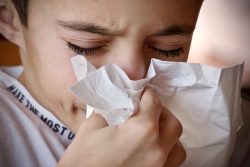In the US alone, women spend 50 billion dollars on cosmetic products annually. Each day women smear anti-aging, anti-blemish, cover-up, foundation, powder and more on our faces and bodies in the name of beauty. The FDA does not monitor toxins in cosmetic and personal products because we don’t ingest it; however, our skin is the largest organ in our body and absorbs chemicals directly into the bloodstream faster than if it were digested. The digestive system has a natural process to filter toxins, whereas the epidermis acts more like a sponge. This will be the first in a three part series.
We are what we eat AND what we wear.
What are these nasty chemicals lurking in our beauty and bath products, how do we avoid them and most importantly how do we make changes in legislation to protect us?
There are over 10,500 ingredients in personal care products, but the most common and most dangerous are:
Please click on the chemical name for more information.
- Cosmetic Toxin – Triclosan – used as an antimicrobial in soaps and hand sanitizers. Triclosan is a known hormone disrupter and provides a suitable environment for the emergence of antimicrobial drug-resistant bacteria.
- Cosmetic Toxin – Synthetic Musks – used to create scents. Did you honestly think, ‘Midnight Jasmine Hummingbird Orchestra Love Song’ was bottled in a lovely, toxin-free field? The chemicals galaxolide and tonalide are used to make synthetic scents, but also bind to and stimulate human estrogen receptors and have been shown to affect androgen and progesterone receptors. Tonalide increases the proliferation of estrogen-responsive human breast cancer cells and has been identified as a photosensitizer, a chemical that becomes more toxic when exposed to sunlight on the skin. It has also been linked to liver toxicity.
- Cosmetic Toxin – Formaldehyde/Formaldehyde-Releasing Preservative (FRP) – A preservative found in nail polish, eyelash glues, hair gels, hair-smoothing products like Brazilian keratin treatments. FRPs do not have to be listed as an ingredient and can be found in personal care products including baby shampoos, soap and body washes. Formaldehyde is recognized as a known human carcinogen by the United States Department of Health and Human Services and the International Agency for Research on Cancer and has been linked to leukemia. Common ingredients likely to be contaminated with formaldehyde or FRPs include: quaternium-15, DMDM hydantoin, imidazolidinyl urea, diazolidinyl urea.
- Cosmetic Toxin – 1,4-dioxane – Commonly seen as, “sodium laureth sulfate” on shampoo and soaps is used as a foaming agent. It is listed by the California Environmental Protection Agency as a suspected kidney toxicant, neurotoxicant and respiratory toxicant. Other ingredients likely to be contaminated: PEG-100 stearate, polyethylene, ceteareth-20.
- Cosmetic Toxin – Hydroguinone – Used as a skin lightener and considered one of the most dangerous toxins in cosmetics. Hydroguinone is also found as an impurity in ingredients in facial and skin cleansers, facial moisturizers and hair conditioners. The Environmental Working Group (EWG) found the ingredient tocopheral acetate, and any ingredient with “toco” in the root, is at risk for contamination. Hydroguinone decreases the production of melanin pigments in the skin and simultaneously increases exposure to UVA and UVB rays, thus increasing skin cancer risks.
- Cosmetic Toxin – Phthalates – Used to hold color and scents and aren’t usually listed except for in nail polish. A loophole in regulations allows phtalates to be added to fragrances (and therefore almost every cosmetic and personal care product) without being added to the label. Extensive research suggests that phthalates disrupt hormonal systems by reducing the level of sex hormones. Exposure in pregnant women has been linked to shortened distance between the anus and genitals of male babies indicating feminization occurred during genital development. Exposure in adult human males is associated with poor sperm quality and infertility. In women, phthalates have been shown to cause an increase of breast tumor cells and reduces the effectiveness of anti-estrogen treatments against tumors.
- Cosmetic Toxin – Parabens – Used in products to prevent growth of microbes. “Parabens,” actually describes several chemicals with similar molecular structure, but the most common to cosmetic products are: ethylparaben, butylparaben, methylparaben and propylparaben. Parabens have been linked to cancer, endocrine disruption, reproductive toxicity, immunotoxicity, neurotoxicity, and skin irritation.
- Cosmetic Toxin – Lead and other heavy metals – Metals including arsenic, mercury, aluminum, zinc, chromium, and iron have been found in lipstick, foundation, whitening toothpaste, eyeliner and more; both as intentional ingredients and as contaminants. Titanium dioxide and zinc oxide are often used in sunscreens (I will get into the dangers of sunscreen in a separate post), foundation, concealer, and diaper rash ointments. Iron oxides, aluminum, and chromium are used as a colorant in make-up. Color additives like D&C Red 6, may contain contaminants including arsenic, lead, and mercury. Zinc is used in moisturizers, shampoos and foundations. Heavy metal poisoning in the body can have a variety of adverse health concerns including neurotoxicity, endocrine disruption, birth defects, cancer, and more.
- Cosmetic Toxin – Nitrosamines – An impurity and, therefore, not a labeled ingredient. Nitrosamines is a known impurity in 53 ingredients and virtually every cosmetic and personal care product including baby products, sunless tanning lotion and pain relief salves. They are actually created in products when nitrates and various amino acids are combined. Specifically, when diethanolamine (DEA) or triethanolamine (TEA), used to adjust the pH of products, are used in products with preservatives that break down into nitrates. Numerous studies have linked nitrosamines to cancer. They are listed by the EPA, International Agency for Research on Cancer, the US National Toxicology Report on Carcinogens and the California Prop 65 as chemicals known to cause cancer or birth defects. And if that wasn’t severe enough, nitrosamines are linked to endocrine disruption, developmental or reproductive toxicity, immunotoxicity, neurotoxicity and systemic toxicity.
So, you buy organic and natural products to protect yourself and your family, right? Well, more bad news: In the world of cosmetics the words natural, herbal, and even organic have no legal definition. Unfortunately, companies slap an organic sticker on products and then raise the price for unsuspecting consumers more often than not. The only way to truly protect your family is to make your own personal care products or research the products you buy. The good news is the EWG has created an electronic database analyzing 70,547 products and 2,912 brands of these dangerous products. The EWG’s Skin Deep database is an amazing tool to protect both your health and your wallet.
Furthermore, we can take action. First, stop buying products containing these chemicals. Second, spread the word. Not only are you saving someone’s health and potentially life, but you are taking away more customers, eventually forcing these companies to change their ingredients. Third, join or start a campaign to force legislation and regulations to protect the consumer. Organizations like the Environmental Working Group and The Campaign for Safe Cosmetics are dedicated to awareness and change, and have tools for consumers to lobby for change.
Photo by ehensley, Creative Commons












